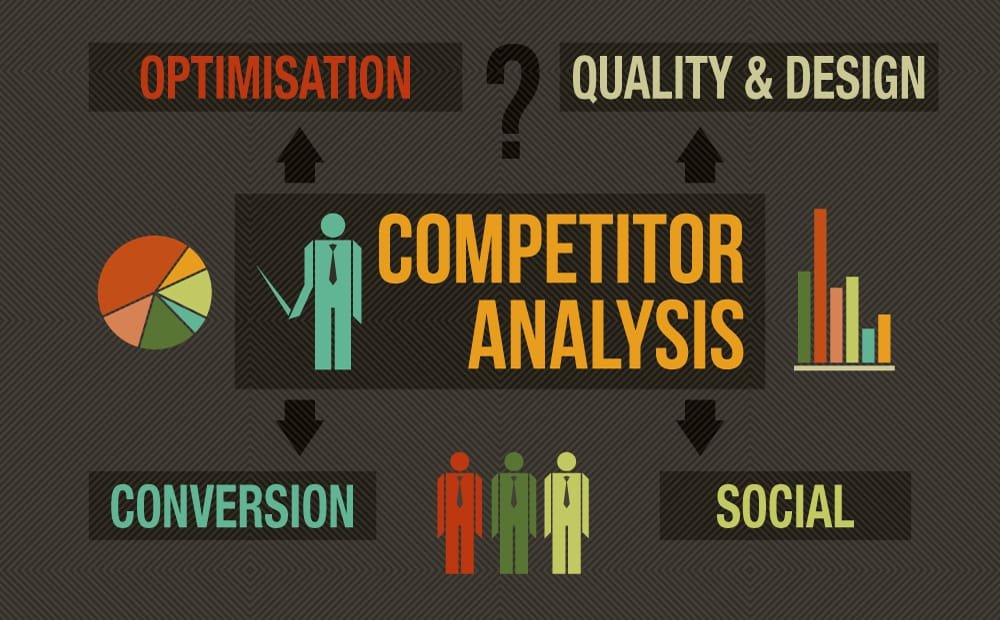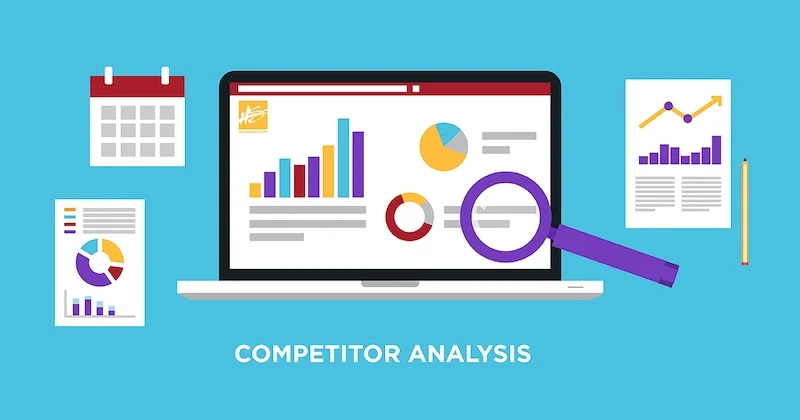Competitor analysis in digital marketing is the process of evaluating the digital marketing strategies of businesses that compete in the same space as your brand. This analysis focuses on understanding their strengths, weaknesses, and marketing efforts to refine your own digital strategy. Learning how to do competitor analysis in digital marketing involves assessing competitors’ use of SEO, paid ads, social media, and content marketing.

A well-executed digital marketing competitor analysis is essential because it offers insights into industry trends, customer preferences, and what strategies are working for others. By identifying key areas where competitors excel or falter, businesses can optimize their own digital marketing strategy and achieve sustainable growth. For Mastodon Marketing, competitor analysis is a vital tool to stay ahead of the curve in an increasingly crowded market.
Why Competitor Analysis Matters for Your Digital Marketing Strategy?
Conducting a thorough competitive analysis is crucial for refining and improving your own digital marketing strategy. By analyzing the digital marketing efforts of competitors, you can uncover valuable insights that directly impact your marketing decisions. Understanding what works for your competitors can inform the tactics you adopt, from content marketing to paid advertising.

Additionally, competitor analysis helps you identify gaps in the market where your business can thrive. Gaining these valuable insights allows you to adjust your strategy to capture market opportunities while avoiding potential threats.
By regularly monitoring your competitors, you can continuously refine your marketing strategy, ensuring it aligns with current industry trends and consumer behaviors. Ultimately, this approach leads to better digital performance and positions your business to stay competitive in a rapidly evolving market.
Types of Competitors in Digital Marketing: Direct and Indirect
In digital marketing, competitors are generally classified into two main types: direct competitors and indirect competitors. Direct competitors are businesses that offer similar products or services and target the same customer base. For instance, if you run a digital marketing agency like Mastodon Marketing, other marketing agencies offering similar services to the same audience would be considered direct competitors.
On the other hand, indirect competitors provide alternative solutions to the same customer needs. These businesses may not offer the same services as you, but they still compete for your target audience’s attention and spending. For example, a software company offering DIY digital marketing tools could be an indirect competitor to an agency that provides full-service solutions.
To effectively identify competitors, businesses can use competitor research tools like SEMrush or Similarweb. These platforms help analyze both direct and indirect competitors’ digital presence, enabling you to track their performance, content strategies, and customer engagement. Identifying competing brands is essential for understanding the broader competitive landscape and crafting a more comprehensive digital marketing strategy that addresses both direct threats and alternative solutions in the market.
Essential Steps to Conduct a Thorough Competitor Analysis
To conduct a competitive analysis in digital marketing, follow these essential steps:
- Identify Key Competitors: Start by researching both direct and indirect competitors. Tools like SEMrush, Similarweb, and Ahrefs can help you identify the most relevant competitors based on their digital presence and performance.
- Analyze Competitor Websites: Visit competitors’ websites to assess their design, user experience, content, and functionality. Look at how they position their products or services and the types of customer engagement features they offer.
- Review Product Offerings and Pricing: Examine what products or services your competitors offer and compare their pricing structure. Understanding their value propositions helps you refine your own strategies.
- Customer Satisfaction: Analyze competitor reviews, testimonials, and customer feedback across various platforms to gauge overall customer satisfaction. Look for recurring complaints or praises to identify their strengths and weaknesses.
- Gather Data Using Tools: Use tools like SEMrush and Ahrefs to monitor competitors’ rank and strategies. These platforms can track competitors’ keyword rankings, traffic, and marketing channels, providing a complete overview of their digital tactics.
By conducting a thorough competitive analysis, you can uncover insights that will inform your own digital marketing strategy, giving you a competitive edge in the market.
Analyzing Competitors’ SEO Strategy
To evaluate your competitors’ SEO strategy, start with keyword research. Tools like SEMrush or Ahrefs can reveal the keywords your competitors are ranking for, helping you understand their focus areas. Analyze their on-page SEO by looking at title tags, meta descriptions, headings, and content structure. This will give insights into how they optimize their site for search engines.
Additionally, conduct a backlink analysis to see where their backlinks come from, which can provide opportunities for you to build similar connections. Strong backlinks indicate authority, so understanding their backlink profile helps refine your link-building efforts.
By thoroughly evaluating competitor sites and their SEO tactics, you can improve your own SEO strategy. Identifying gaps and gaining insights from their successes and shortcomings will enable you to refine your own approach and rank higher in search engine results.
Evaluating Social Media Presence and Engagement
Analyzing your competitors’ social media presence is vital for understanding how they engage with their audience across various social media platforms like Facebook, Instagram, LinkedIn, and Twitter. Tools like Hootsuite and Sprout Social can help track their performance, including the frequency of posts, types of content, and follower growth.

Pay close attention to social media engagement, such as likes, shares, comments, and overall user interaction. Identify which types of content resonate most with their audience and see how consistently they maintain engagement across channels.
Understanding your competitors’ social media strategy gives you a benchmark to refine your own approach. By knowing what works for them on digital platforms, you can create content that appeals to your target market, enhancing your visibility and engagement on social media. Ultimately, improving your social media presence leads to greater brand awareness and stronger customer relationships.
Understanding Competitors’ Content Marketing Strategy
To gain insights into your competitors’ content marketing strategy, start by evaluating their content types, such as blog posts, videos, case studies, and email marketing campaigns. Review the consistency and quality of their content, as well as how they tailor it to engage their audience.

Tools like BuzzSumo can help you analyze which of your competitors’ content performs best by tracking social shares, backlinks, and overall engagement. Identify the topics and formats that generate the most traction, whether it’s in-depth guides, video tutorials, or infographics.
By understanding your competitors’ content strategies, you can refine your own digital marketing campaigns by producing content that fills gaps, addresses customer pain points, or provides more value. Keeping an eye on successful content types helps you stay competitive in the digital space and better meet your audience’s needs.
Analyzing Paid Advertising Campaigns
Competitor analysis should also include reviewing their paid advertising efforts. Evaluate how your competitors use paid ads on platforms like Google Ads, Facebook Ads, and LinkedIn Ads. Track the types of ads they run, their targeting strategies, and the frequency of their campaigns.
Using tools like SEMrush, you can analyze paid search performance to understand which keywords and ad placements your competitors are prioritizing. You can also estimate their advertising spend, which provides insights into their budget allocation for different channels.

By understanding competitors’ paid advertising tactics, you can optimize your own marketing campaigns. Whether adjusting your keyword strategy, crafting more compelling ad copy, or exploring new ad formats, analyzing competitor ads can help you enhance your digital marketing efforts and drive better results from paid media.
Spotting Opportunities and Threats in the Market
Conducting a SWOT analysis—which evaluates strengths, weaknesses, opportunities, and threats—is an essential step in identifying both market opportunities and potential challenges. This analysis can help you identify gaps in the digital landscape that your competitors might be overlooking.
Look for emerging market trends and evolving customer needs that your business can address. Tools like Google Trends or SEMrush can reveal shifts in customer behavior or interests. Additionally, closely monitor competitor strategies to pinpoint areas where they are underperforming or failing to meet customer expectations.
By identifying both opportunities and threats, you can make informed decisions to strengthen your market position. Leveraging these insights allows you to capitalize on untapped potential, stay ahead of market threats, and refine your strategy to ensure long-term growth and competitiveness in the digital marketplace.
Identifying Your Competitors’ Strengths and Weaknesses
To gain a competitive advantage, it’s crucial to evaluate your main competitors’ strengths and weaknesses. Start by analyzing their product offerings, digital presence, and customer feedback. Look at what makes them successful—whether it’s superior products, strong online engagement, or effective customer service.

On the flip side, identifying weaknesses such as poor customer reviews, inconsistent digital strategies, or gaps in their product range can reveal opportunities for your business. Tools like SEMrush or Similarweb can help you analyze competitors’ performance metrics, while customer feedback platforms provide insights into their reputation.
By understanding where your competitors fall short, you can tailor your strategy to fill those gaps, positioning your business as a better alternative. Focusing on these weaknesses allows you to differentiate your brand and capitalize on areas they are neglecting, helping you build a competitive advantage in the marketplace.
Creating a Competitive Analysis Framework
Developing a competitive analysis framework ensures consistent and ongoing competitor research. Start by using tools like SEMrush and Ahrefs to track competitors’ SEO, paid ads, and content marketing strategies. A well-structured framework should include regular monitoring of key competitors, tracking their website traffic, keywords, and social media engagement.
This framework allows you to regularly assess how competitors respond to market changes and evolving customer preferences. Monitoring the competitive landscape is essential to staying relevant and proactive, rather than reactive, in a dynamic market.
By conducting regular competitor analysis, you can quickly adapt your strategy as needed. This consistent observation not only helps you stay competitive but also uncovers emerging trends, new opportunities, and potential threats that could impact your business in the long run.
Using Tools to Monitor Competitors in Digital Marketing
Several powerful tools are available to help you monitor digital marketing competitors. SEMrush and Ahrefs are excellent for tracking key metrics like keyword rankings, backlinks, and paid ad performance. These tools allow you to analyze competitors’ SEO strategies and discover which marketing channels are driving the most traffic.
Hootsuite and Sprout Social are effective for tracking social media engagement and performance, giving insights into how your competitors engage with their audience on platforms like Instagram, Facebook, and LinkedIn. Similarweb and Moz can provide an overview of competitor web traffic, helping you understand their overall digital presence.
By using these tools for competitor analysis, you can keep a pulse on the market and ensure that your business is adjusting to the evolving competitive landscape. Monitoring competitors is key to staying informed and gaining insights that help you refine your strategies for long-term success.
Creating a Competitor Analysis Report
A competitor analysis report consolidates all the insights gained from your research into a clear and actionable document. Start by organizing your findings into categories like SEO performance, paid advertising, content marketing, and social media engagement. Tools like Google Data Studio are useful for creating visually appealing reports that summarize key data points.
The report should highlight the strengths and weaknesses of your competitors, as well as opportunities for improvement in your own strategy. Include recommendations based on the data, such as adjusting your keyword strategy or exploring new content formats.
A well-structured competitor analysis template will allow you to track ongoing performance and update your marketing plan as market dynamics evolve. By analyzing valuable insights gained from competitor research, you can make informed decisions that enhance your marketing efforts and give you a competitive edge.
Leveraging Competitor Analysis for Business Growth
Competitor analysis is an invaluable tool for driving business growth by improving your digital marketing strategy. Regularly assessing competitors’ strengths, weaknesses, and tactics ensures that your business stays competitive and adaptable to emerging trends.
By continuously monitoring the market landscape and adjusting your strategy accordingly, you position your business to not only keep up with competitors but also to outpace them. Make competitor analysis a central part of your strategy to stay ahead and seize opportunities for sustained growth in the digital marketplace.



